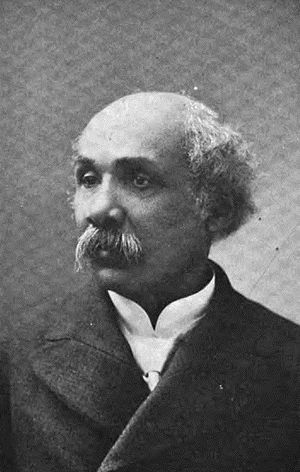William Hannibal Thomas facts for kids
William Hannibal Thomas (born May 4, 1843 – died November 15, 1935) was an important American figure. He was a teacher, journalist, judge, writer, and lawmaker. He spent his life fighting against racism. He faced challenges like riots at Otterbein University, which made him leave.
In 1861, he tried to join the Union Army but was turned away. He finally joined in 1863 and was wounded in battle. This injury led to his right arm being amputated. Later, he wrote books about the challenges faced by Black people in America.
Contents
William Hannibal Thomas's Life
Early Years and Education
William Hannibal Thomas was born in Pickaway County, Ohio. His family had been enslaved in the past. In 1859, he became the first Black student to attend Otterbein University.
Serving in the Civil War
During the American Civil War (1861–1865), Thomas bravely served in the 5th United States Colored Infantry Regiment. He was shot during the war, and his right arm had to be removed. After the war, he continued his education at Western Theological Seminary in Pennsylvania.
Life in South Carolina
After the war, Thomas lived in Newberry County, South Carolina. He worked as a judge, holding hearings. People described him as a smart and well-educated man. He was a veteran of the Union army.
Career as a Writer and Politician
From 1865 to 1870, Thomas wrote for The Christian Recorder. This was the national newspaper of the African Methodist Episcopal Church. He wrote 28 articles sharing his thoughts on Black life, religion, and politics.
In 1871, he worked as a teacher. Then, in 1873, he earned a license to practice law in South Carolina. He also taught for a short time at Wilberforce University in Ohio.
Thomas became a member of the South Carolina Legislature during the Reconstruction period. During this time, he openly supported Black people defending themselves against violence.
In 1878, President Rutherford B. Hayes appointed Thomas as a U.S. consul. This meant he represented the U.S. in Portuguese Southwest Africa (which is now Angola).
His Books and Ideas
William Hannibal Thomas started his own journal called The Negro. He also wrote a very famous book, The American Negro, published in 1901. In this book, he wrote that the problems faced by Black people were due to their own character and behavior, not just racism. He said that Black people were "deteriorating" and faced issues like poverty and immorality.
His writings were unfortunately used by white racists. They used his words to support their own ideas that white people were superior and Black people were inferior.
Reactions to His Book
Many important Black thinkers strongly disagreed with Thomas's book. Leaders like Booker T. Washington and W. E. B. Du Bois criticized his ideas. They tried to stop his book from being widely read.
Booker T. Washington's View
Booker T. Washington disagreed with Thomas's descriptions of Black people. Washington pointed out that Thomas claimed Black people were not successful in owning land. But Washington showed statistics from Virginia and Georgia that proved Black land ownership was actually increasing. He also felt Thomas wanted Black people to rely too much on the government.
Washington believed Thomas contradicted himself. For example, Thomas said Black people did not gamble, but then claimed gambling was a major flaw. Washington also noted that Thomas said the Black population was not growing much, but then claimed it was growing by millions. Washington felt Thomas's evidence was based on stories, not facts. He believed Thomas did not truly connect with Black communities in the South.
W.E.B. Du Bois's View
W.E.B. Du Bois also strongly criticized Thomas's book. Du Bois found the book's tone to be very sad and hopeless. He described it as having "cynical pessimism" and "glaring self-contradictions." Du Bois thought that the difficulties of Black life had affected Thomas. He believed Thomas had become a "cynic."
Du Bois noted that Thomas had first written a shorter version of his ideas in 1890. This earlier version did not get much attention. When he rewrote it into the 1901 book, he reused many old ideas. Du Bois felt this caused the contradictions in the book. The older ideas were more hopeful and blamed white people for problems. But the new book shifted the blame to Black people themselves. Du Bois believed that because Thomas had removed himself from the Black community, his original opinions from the earlier pamphlet were more accurate.
Later Life
William Hannibal Thomas passed away in Columbus, Ohio in 1935.
See also


